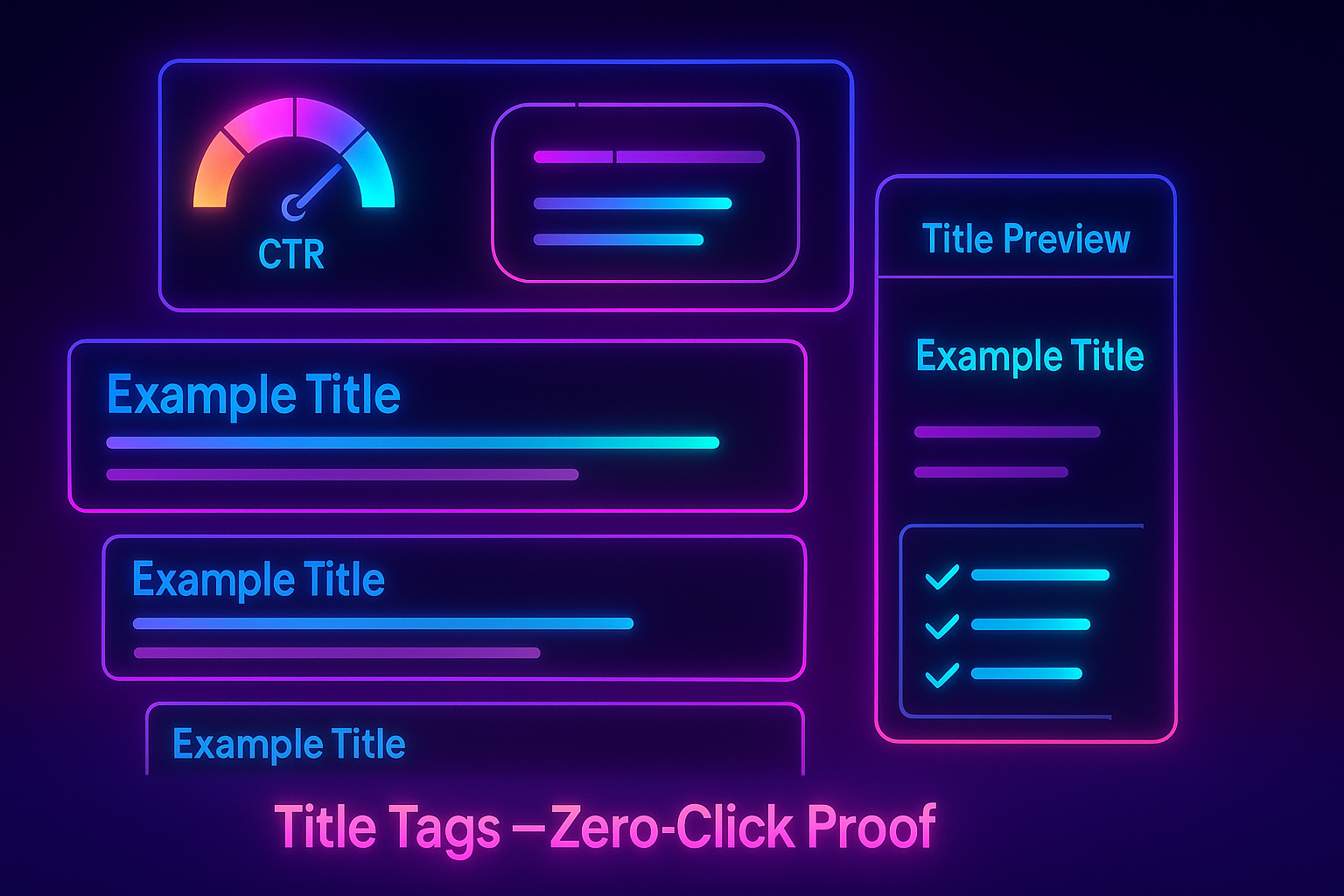A 2025 playbook to make title tags win clicks in a zero-click world—map intent, earn scannability, protect truncation, and preview everything with SEO Horizan tools. Includes templates, QA, and prioritization.
zero-click searches proof your title tags strategy (2025)
Answer boxes and AI summaries reduce clicks, but not intent. In 2025, title tags still earn visits when they match intent, promise next-step value, and survive truncation. Use this playbook—and preview everything with SEO Horizan—to keep titles competitive in zero-click SERPs.
What “zero-click-proof” means for titles
- Intent-first: Lead with the job to be done (how-to, template, pricing, comparison).
- Non-SERP value: Promise what the panel/snippet can’t deliver (download, calculator, step-by-step).
- Scannability: Exact task nouns + outcome words (“setup”, “benchmark”, “calculator”).
- Truncation-safe: Front-load key terms; keep the decision phrase in the first ~55–60 chars.
- Consistency: Title ↔ H1 ↔ meta description ↔ on-page snippet paragraph.
Rapid workflow (10–20 minutes per URL)
- Preview & pixel width: Open Google Search Preview. Tune until the core promise fits the visible line.
- Meta & OG parity: Validate with Meta Tags Checker and OpenGraph Checker.
- On-page alignment: Confirm the H1 and 40–55 word snippet appear verbatim using Website Text Extractor.
- Link hygiene: Ensure internal links in the intro point to final 200s via URL Redirect Checker and sanity-check headers in HTTP Headers Lookup.
Title building blocks (copy, then adapt)
- Problem → Outcome: [Problem]: [Outcome] (2025 guide)
- Asset promise: [Topic] Template/Checklist + Examples (2025)
- Comparator: [X] vs [Y]: key differences, pricing & use cases
- Pricing intent: [Product] pricing: plans, limits & calculator (2025)
- Benchmarks: [Metric] benchmarks for [Audience] (2025 report)
Title patterns that fight zero-click
Pair the promise with a must-visit artifact.
| Intent | Title Pattern | Non-SERP Value Teased |
|---|---|---|
| How-to | [Task]: step-by-step + pitfalls (2025) | Downloadable checklist |
| Template | [Topic] Template + filled example (2025) | CSV / Google Sheet |
| Comparison | [X] vs [Y]: which to pick in 2025 | Annotated table |
| Pricing | [Product] pricing: plans & calculator (2025) | Interactive calculator |
| Benchmark | [Metric] benchmarks for [Audience] (2025) | Segmented dataset |
Do/Don’t rules (2025)
- Do front-load the task (“Internal links quick wins”), then the hook (“+ templates”).
- Do include the year only when freshness is material.
- Do keep brand at the end for head terms (e.g., “— SEO Horizan”).
- Don’t lead with brand on non-brand queries.
- Don’t stuff synonyms; one crisp descriptor beats three vague ones.
Programmatic titles (safe automation)
For directories or pSEO pages, create a ruleset with guardrails.
IF page_type = "template"
title = "{{topic}} Template + Example (2025) — {{brand_short}}"
ELSE IF page_type = "comparison"
title = "{{x}} vs {{y}}: key differences & use cases — {{brand_short}}"
ELSE IF page_type = "pricing"
title = "{{product}} pricing: plans & calculator (2025) — {{brand_short}}"
Guardrails: 60–65 char soft cap; collapse duplicate tokens; ensure city/product names are normalized.
Snippet & title alignment (copy this)
<!-- H1 mirrors title without brand tail -->
<h1>[Task]: step-by-step + pitfalls (2025)</h1>
<p class="snippet">[40–55 words: the concrete outcome, the specific asset users get, and who it's for.]</p>
QA checklist (publish-time, 10 minutes)
- ✅ Fits and sells in Google Search Preview (no mid-word truncation).
- ✅ Title/description/OG consistent (Meta Tags, OpenGraph).
- ✅ Snippet paragraph visible and aligned (Website Text Extractor).
- ✅ Intro includes at least one internal link to a must-visit asset or calculator and resolves to 200 (URL Redirect Checker).
- ✅ Page is fast and stable: TTFB < 600 ms; payload < 2 MB (TTFB, Page Size).
Title templates (fill-in-the-blanks)
[Topic] checklist + examples (2025)
[Task] in [Tool]: the fast, safe setup (2025)
[Product] pricing: plans, limits & calculator (2025)
[Metric] benchmarks for [Audience] (2025 report)
[X] vs [Y]: which to choose for [Use case] (2025)
[Industry] templates: editable [doc type] + tips
Prioritization (do now → do next)
Item, Impact, Effort, Priority
Rewrite top 20 titles with intent + asset promise, High, Low, Do Now
Add/align snippet paragraphs on those pages, High, Low, Do Now
Standardize programmatic title rules + caps, High, Medium, Do Now
Tune OG images for social parity, Medium, Low, Next
Fix redirecting intro links to final 200, Medium, Low, Next
Refresh titles with year where freshness matters, Medium, Low, Next
Where to link internally
- From this guide to your Blog hub templates and related copy playbooks.
- From high-traffic posts back to this strategy to keep editors aligned.
- Ensure all priority pages are present in your Sitemap.
SEO Horizan Toolbox (bookmark these)
- Google Search Preview • Meta Tags Checker • OpenGraph Checker
- Website Text Extractor • URL Redirect Checker • HTTP Headers Lookup
- Website Page Size Checker • TTFB Checker • Text-to-HTML Ratio Checker
FAQs
What length should titles be in 2025?
Optimize for pixels, not characters. Keep the decision-making phrase in the first ~55–60 chars and verify in a preview tool.
Should I include the year?
Yes when freshness matters (benchmarks, platform changes). Skip it for evergreen concepts unless it aids CTR.
Where should the brand go?
Tail position for non-brand queries (“ — Brand”). Lead with brand only on branded searches or corporate pages.
Can I automate titles for programmatic pages?
Yes—with strict patterns, caps, and deduplication. Always preview a sample and align H1 + snippet to prevent mismatch.
Wrap-up
Zero-click isn’t the end of clicks—it’s the end of vague titles. Lead with the task, tease non-SERP value, and preview every title before you ship. Use the templates and QA above, then standardize rules across your CMS. When you’re ready to operationalize this, create an account or compare Plans.
